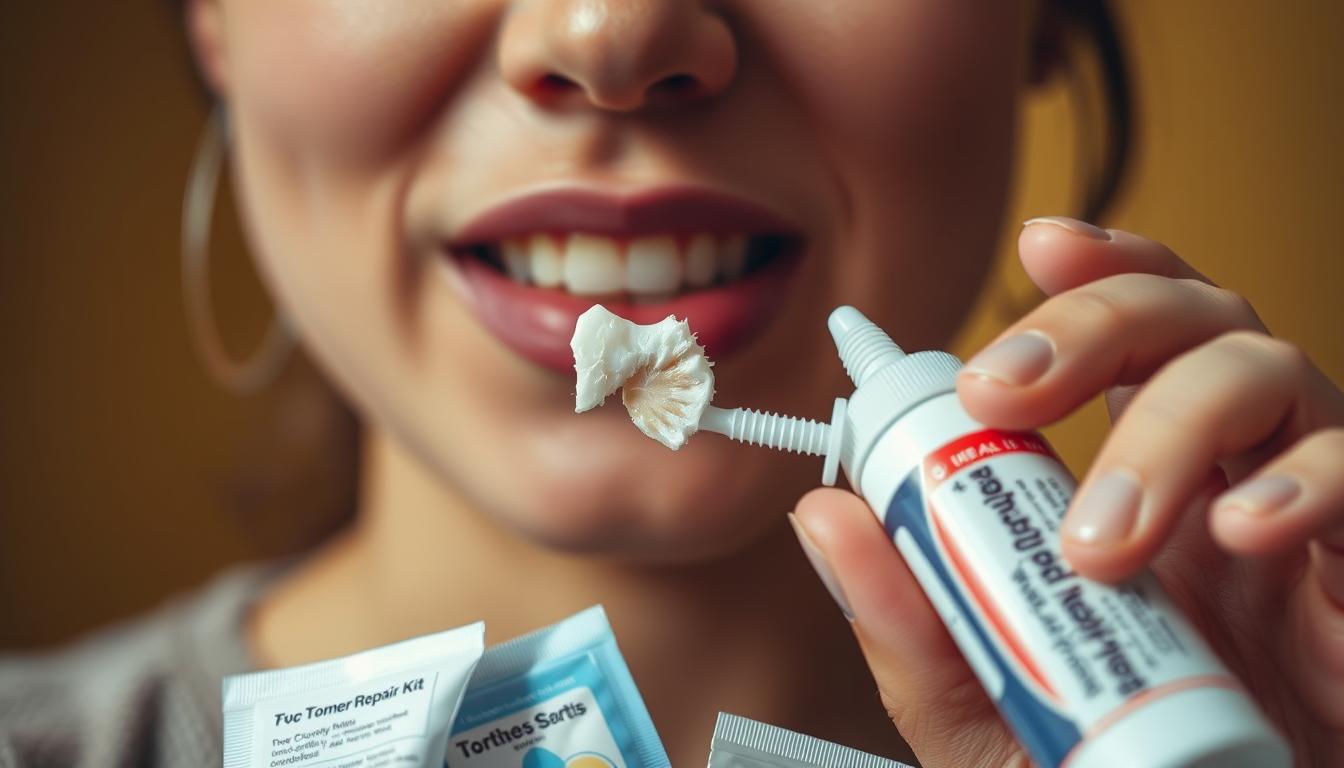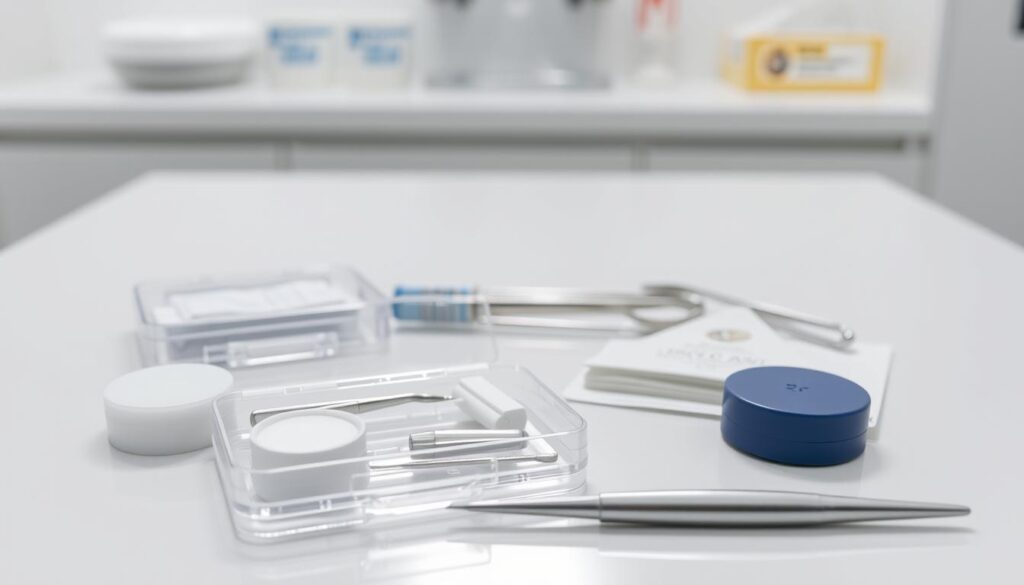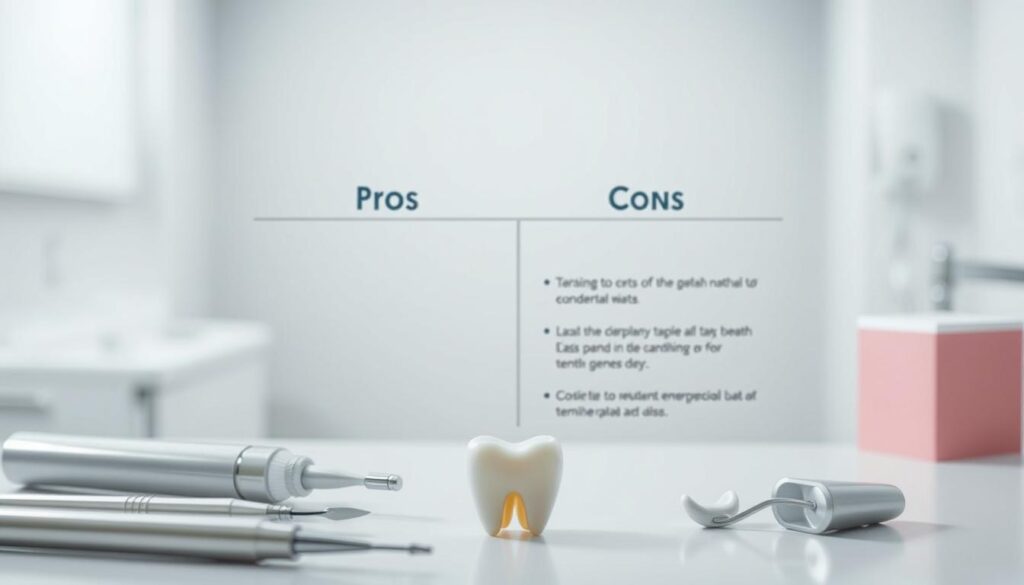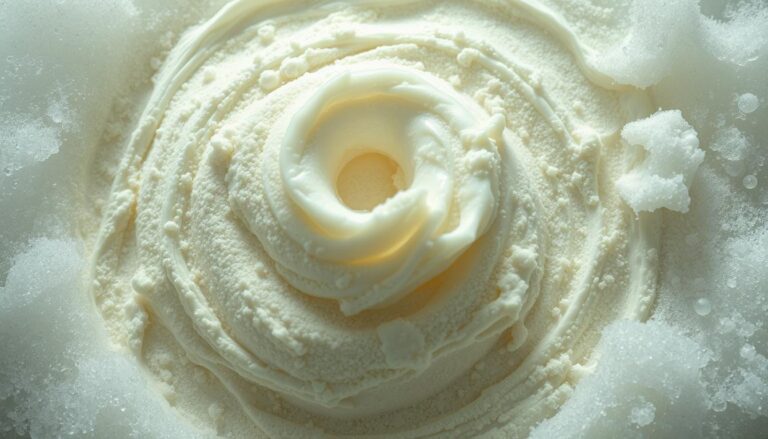Can I Use Temporary Repair Kits or Superglue on a Broken Tooth?

One in five people who visit the dentist urgently do so because of a cracked or broken tooth. This statistic comes from the American Dental Association. It’s quite alarming. Many at home wonder if they can fix a broken tooth with temporary repair kits or superglue.
If a piece of your tooth breaks off, a temporary fix might help protect any exposed areas until you can get proper care. Drugstores sell approved temporary cements and protective pastes just for this reason. They can make sharp edges less harmful and decrease pain. This helps as you set up a time for emergency dental care for your broken tooth.
But, superglue is a different story. It’s made from cyanoacrylate, which can irritate, harbor bacteria, and make professional treatment harder. These glues are not safe for your teeth and could even increase your risk of getting an infection. So, it’s clear: only use products made for teeth, and avoid regular glues.
While you’re waiting to see a dentist, rinsing with warm salt water is good. Also, stay away from food and drinks that are very hot or cold, and don’t eat sugary things. If you don’t have a repair kit, use a bit of sugarless gum or soft wax to cover any sharp parts. Then, hurry to contact an emergency clinic or your usual dentist for the right care and advice.
Key Takeaways
- Temporary dental kits can provide short-term protection; household glues, including superglue, should never be used on natural teeth.
- A broken tooth can be a dental emergency; arrange emergency dental care for broken tooth evaluation as soon as possible.
- Use warm salt-water rinses and avoid hot, cold, and sugary items to reduce pain and sensitivity.
- Sugar-free gum or paraffin wax may cover sharp edges briefly if no kit is available.
- Superglue can be toxic, trap bacteria, and complicate later repairs—stick to products intended for oral use only.
- Keep the area clean and protected until a dentist confirms the extent of damage and provides definitive treatment.
Understanding Broken Teeth
Broken teeth have different types based on what part failed: enamel, dentin, or pulp. A small chip from eating popcorn is not the same as a deep crack from an injury. Before attempting to fix a broken tooth yourself, find out the type of break, how sensitive it is, and if there’s bleeding or swelling.
Why does this matter? Knowing the kind of damage helps decide on a quick fix and when to see a dentist. Early steps can safeguard against further injury until professional treatment is available.
Types of Tooth Breaks
Minor chips in the enamel might only need composite bonding. If the dentin is showing, veneers or crowns may be necessary. For cracks below the gumline, pulling the tooth and getting an implant might be the best option.
Cracked tooth syndrome means pain when you stop biting down. Vertical root fractures are tricky to spot and can feel like sinus pain. Knowing the pattern helps judge if a home fix is safe or worth trying.
Common Causes of Tooth Damage
Accidents, like getting hit in the mouth while playing sports, happen often. Hard foods or candies can also damage teeth or make small cracks worse. Grinding teeth at night slowly wears them down.
Old, large fillings can cause problems. Extreme temperature changes, like drinking hot coffee then ice water, stress the teeth. Understanding the cause is crucial when considering DIY tooth repair to avoid making things worse.
Symptoms of a Broken Tooth
Sharp tooth edges can cut your tongue or inside of your cheek. If it hurts with hot, cold, or sweet things, the dentin might be exposed; intense pain could mean the pulp is damaged. Bleeding or swelling shows injury.
Pain while eating, feeling like your teeth don’t line up right, or changes in how you talk could be signs of a big break. If the tooth’s inner parts are open, bacteria can get in, leading to more trouble. That’s why trying a quick fix at home should be careful, aiming to protect the tooth until you can get to a dentist.
Temporary Repair Kits for Dental Use
When a tooth chips or a crown feels loose, time is essential. Over-the-counter kits can offer a quick fix. They protect your gum and reduce pain until you see a dentist. These kits can be a lifesaver in a dental emergency without causing harm.
Key idea: Think of them as temporary covers for comfort, not as a lasting solution. This is the right way to handle a broken tooth at home.

Overview of Temporary Repair Kits
Most kits you find in stores have cotton, antiseptics, and soft materials. These act like a protective wax, easing irritation. They’re safe for temporary use when you follow the directions.
But, adhesive resins are for fake teeth, not your own. For a real broken tooth, use non-stick coverings and see a dentist soon.
Popular Brands and Their Features
Brands like Dentek and Red Devil are common in U.S. stores. They come in single-use packs to stay clean. Kits for fake teeth often have waterproof glues and resins.
For your own teeth, look for kits with soft putty and cleaners. These are good for emergencies, without using permanent glues.
| Brand/Category | Primary Use | Key Components | Suitable Scenario | Important Limitation |
|---|---|---|---|---|
| Dentek Temparin Max | Lost filling/crown cushion | Temporary filling material, applicator | Sensitivity relief, short-term sealing | Not a permanent restoration |
| Dentek Repair Kit | Edge smoothing, comfort | Soothing compounds, tools | Protects soft tissue from sharp enamel | Avoids permanent bonding |
| Denture Repair Kits (various) | Prosthetic repair | Single-use epoxy, acrylic resin | Cracked denture base or tooth | Not for natural teeth |
| Temporary Cushioning Wax | Tissue protection | Medical-grade wax | Covers jagged edges | Short wear time |
How to Apply Temporary Kits
First, clean and dry the area. Rinse with warm water and dry off well. Apply a small amount of safe, non-stick material on any sharp parts. This approach prevents further damage without fully sealing the tooth.
- Make sure your hands are clean and you have good lighting.
- Use just a little material to avoid it falling out when you chew.
- Wait for it to set before eating or drinking.
- Don’t use glues on your own teeth, only on fake ones.
Following these steps ensures you use the kit safely. It helps with the pain while you wait for professional help.
Using Superglue as a Dental Fix
A broken tooth can make you panic and search for quick fixes. Some even try superglue, but it’s not compatible with your mouth. It’s smart to look for short-term solutions, but not if they harm you in the end.
Risks of Using Superglue on Teeth
Superglue can irritate your gums and increase infection risk. And saliva can weaken the glue, so it may not last. This can let food get stuck in the tooth.
Glue can damage or stain your teeth. If you use the wrong glue, it can trap bacteria and make it hard to see tooth damage. This makes future dental work harder.
Why Dentists Advise Against Superglue
To fix a glue repair, dentists may need to remove more of your tooth. This means longer and more expensive dental visits. The glue can also mess with how future repairs bond to your tooth.
Dentists worry that superglue can hide the real issues with a tooth. It may seem easy, but it can lead to worse problems later. It messes up dental work that needs a clean surface to stick to.
Alternatives to Superglue for Quick Fixes
There are safer ways to deal with a toothache until you can see a dentist. These tips help reduce pain without risky DIY methods.
- Cover sharp edges with softened paraffin wax or sugar-free gum to shield the tongue and cheek.
- Rinse with warm salt water to reduce bioburden and ease soreness.
- Avoid very hot, cold, or sugary foods to minimize sensitivity and pulpal stress.
- Call an emergency dentist promptly for definitive evaluation and restoration.
These steps help care for your mouth without dangerous chemicals. They protect your teeth while you wait for safe, professional help.
Pros and Cons of Temporary Repair Kits
If you chip a tooth or have a loose crown, temporary tooth repair kits are a go-to until you can get proper care. These kits can make sharp edges less harmful and ease your pain. However, there are limits to what they can do for a broken tooth.

Advantages of Using Temporary Kits
Brands like DenTek and CVS Health offer kits that can cover a jagged tooth edge. This helps protect your tongue and cheeks. It also eases the discomfort from air and cold.
Denture repair kits use special materials to fix a tooth or crack temporarily. They come with clear instructions, making them handy in urgent situations.
- They offer a quick fix when you can’t see a dentist right away.
- They prevent damage to your cheeks and reduce pain from sharp edges.
- They help keep dentures working until you can get a professional fix.
Disadvantages and Limitations
These kits aren’t meant to permanently fix natural teeth. Using the wrong glue can harm your tooth and make future repairs tough.
Even materials meant for fake teeth aren’t good for real ones and could cause allergies. The fixes might not last in your mouth. Plus, they won’t solve deeper tooth problems. Waiting too long for real treatment can make things worse.
- The underlying issue remains even after a temporary fix.
- Materials might not hold up to normal eating.
- Using them wrong can lead to bigger problems later.
| Use Case | Helpful Role | Key Limits | Best Practice |
|---|---|---|---|
| Chipped natural tooth (enamel only) | Covers sharp edges; lowers irritation | No structural bonding; may dislodge in saliva | Apply as a protective layer and seek prompt evaluation |
| Lost temporary crown | Short-term reseating with OTC dental cement | Improper seating can affect bite and gum health | Use minimal material and schedule an urgent visit |
| Denture tooth fracture | Restores function with acrylic-based kit | Not for natural teeth; potential allergy to monomers | Follow brand instructions and arrange lab repair |
| Cracked tooth with pain | Provides limited protection from thermal triggers | Does not address pulpal injury or deep fracture | Use as a brief dental emergency temporary fix before diagnosis |
Bottom line: use temporary tooth repair options as short-term protection, then transition to definitive care to prevent complications and preserve long-term oral function.
Seeking Professional Dental Help
Seeing a dentist quickly can mean a simple fix instead of a big problem. Trying to fix a broken tooth yourself might lessen pain but won’t solve the root issue. Getting a dentist to check it is always the safest choice.
When to See a Dentist
If a broken tooth is causing severe pain, has a big piece missing, or won’t stop bleeding, it’s time to seek help. You should also act fast if the tooth is very sensitive to hot or cold, or if you can see yellow or pink inside the tooth.
Even a tiny chip can cause big problems, like cutting your mouth or damaging other teeth. Seeing a dentist early can prevent further damage and decide if a temporary fix will help.
- Severe pain or night pain
- Swelling of the gum or face
- Loose or displaced tooth after trauma
- Metallic taste, bleeding, or cracks reaching below the gumline
Importance of Timely Dental Treatment
Getting to a dentist without delay helps save the tooth and prevents worse problems. Waiting too long can lead to infections and the need for bigger treatments. Acting quickly can often mean simpler, less expensive fixes.
While home fixes may offer temporary relief, they don’t solve underlying issues. Quick professional care can save money, reduce time spent in the dental chair, and keep options open before things get worse.
Our advice is simple: follow up any home treatment with a dentist visit. This ensures your emergency care doesn’t just ease pain now but also protects your tooth’s future health.
At-Home Remedies for Broken Teeth
Short-term care can steady things until you see a dentist. It helps lower irritation, protect inside your mouth, and keeps the area clean. The goal is to stabilize, not to fix it completely.
Natural Alternatives for Tooth Pain
Start with a warm salt-water rinse. It reduces bacteria and helps with pain for a little while. Be gentle to not harm weak enamel.
Stay away from very hot or cold drinks and sugary foods. These can make your tooth more sensitive. Doing this helps without hiding any important signs.
If the broken tooth is sharp, use softened paraffin wax or sugar-free gum on it. This prevents injury to your cheek or tongue. It’s a temporary fix that keeps things safe until you get dental help.
DIY Solutions to Prevent Further Damage
Never use household glues or adhesives. They can cause swelling or infection because they’re not safe for your body. Using such glues can make things worse.
If you have a tooth piece, keep it in milk and take it to your dentist. Don’t try to put it back yourself. This keeps the dentist’s options open.
For dentures, a temporary repair kit might work. It uses acrylic resin. Make sure to follow the instructions, let it dry completely, and don’t put it in your mouth too soon. This advice doesn’t apply to real teeth.
| Action | Purpose | When to Use | Caveat |
|---|---|---|---|
| Warm salt-water rinse | Reduce bacterial load and ease discomfort | 2–3 times daily until dental visit | Do not swish forcefully around loose fragments |
| Avoid heat, cold, and sugar | Limit sensitivity and prevent plaque acidity | Immediately after the break and during recovery | Maintain hydration with room-temperature water |
| Paraffin wax or sugar-free gum barrier | Shield cheeks and tongue from sharp enamel | When sharp edges irritate soft tissues | Replace as needed; this is a broken tooth temporary repair |
| Store tooth fragment in milk | Preserve tissue for clinical evaluation | If a clean fragment is available | Do not scrub the fragment or use soap |
| Denture repair kit (acrylic resin) | Short-term stabilization of prosthetics | Only for dentures, not natural teeth | Allow full curing; avoid oral contact during set |
| Avoid non-dental glues | Prevent chemical injury and contamination | Always | Never attempt to fix broken tooth at home with superglue |
These steps are good for treating a broken tooth at home. They help protect your mouth, lower irritation, and get you ready for the dentist.
The Role of Dental Insurance
Insurance makes a tooth injury less scary by planning ahead. It’s important to know your plan’s details before any trouble starts. In an emergency, like a broken tooth, you might need approval for big treatments. But, you can still get quick help and a temporary fix right away.

Emergency fixes and basic care are usually covered quickly, but bigger things like crowns and implants take longer. Before choosing how to fix a tooth temporarily, you should check your plan’s yearly limits and rules about using other dentists.
Coverage for Temporary Repairs
Short fixes after a sudden injury might be covered. This includes checking the tooth, X-rays, making sharp edges smooth, and putting in a quick fix or calming dressing. If you need something temporary like bonding or a quick crown, it’s covered differently than the final fix.
- Emergency exam and diagnostics: Often covered more because they help manage pain and figure out the next steps.
- Interim restorations: Plans might limit how often you can get temporary fixes before the final treatment.
- Follow-up: The cost of a temporary might be included with the final repair, which helps avoid paying twice.
Fixing things yourself can make your claim complicated. Home adhesives might mean extra dentist time to remove them, which some plans don’t cover. Choosing professional help early means clearer documentation and easier payment for emergency dental care for a broken tooth.
For a clear guide on what to do for a chipped or broken tooth, check out this urgent chipped-tooth actions guide. It matches what your insurance expects for quick and correct care.
Financial Options for Dental Emergencies
Even when insurance doesn’t cover everything or runs out, many places offer payment plans. These plans can have low or no interest, with set payments each month. This way, you can get the care you need without waiting.
| Scenario | Typical Insurance Approach | Out-of-Pocket Strategies | Key Considerations |
|---|---|---|---|
| Emergency visit with temporary filling | Often covered as emergency/basic service; deductible may apply | Payment plans or health savings accounts | Ask if the temporary is bundled with the final restoration |
| Bonding or provisional crown | May require preauthorization; frequency limits possible | Financing over several months to a few years | Confirm coverage for interim vs. definitive work |
| Definitive crown, veneer, or implant | Usually major service with percentage coverage and waiting periods | Third-party financing and staged treatment timelines | Check annual maximums and out-of-network differentials |
| Complications after DIY adhesive use | Removal/cleanup may not be covered | Discuss itemized fees and potential alternatives | Avoid self-repairs that can void warranties or add costs |
When thinking about how to temporarily fix a tooth, check your plan in one call for diagnostics, quick fixes, and the full treatment. Good paperwork, quick booking, and skipping DIY fixes help claims go smoothly. This reduces costs in a dental emergency.
Long-Term Solutions for Broken Teeth
Choosing the right care for a broken tooth depends on the crack’s depth and location, and how you bite. A quick fix might stabilize it temporarily. However, a permanent fix brings back strength and looks. Dentists think about how the tooth works, its enamel, and the health of its pulp. They compare these against short-term fixes used right after the break.
Goal: save as much of the natural tooth as we can. Replace only the lost parts. Materials like composite resin, porcelain, and zirconia are good because they’re tough, look natural, and stick well.
Small, minor chipped teeth can often be fixed with composite bonding. This resin, cured with light, matches the tooth’s color. When polished, it can last for years under normal use. This treatment is more than just a quick fix.
For bigger, cosmetic issues on front teeth, veneers offer a good solution. Made of porcelain or composite, they cover the front of the tooth. They make the tooth’s color and shape look right again. They’re simpler than full crowns and fix many small problems in one go.
Dental Crowns and Bridges
If a tooth’s structure is weak, a full-coverage crown can protect what’s left. It also helps spread bite forces evenly and lower the risk of more breaks. You can choose between lithium disilicate for its looks and zirconia for its strength in back teeth.
If a tooth is taken out, an implant with a crown can replace it without touching other teeth. If implants aren’t suitable, fixed bridges use the teeth next to the gap to hold a new tooth. The choice depends on gum health, how teeth meet, and what the patient wants.
- Crowns: used for large breaks, teeth treated with root canals, and back teeth that bear a lot of force.
- Implant crown: saves the enamel of neighboring teeth; needs time to fuse with bone.
- Conventional bridge: quicker to do; depends on the health of teeth next to the gap.
While short-term fixes can protect the tooth’s inner parts, crowns or bridges offer a lasting fix. They spread bite forces more evenly and seal the tooth’s edges better.
Root Canals and Other Treatments
If bacteria get into the pulp or a deep crack exposes the inner tooth, root canal therapy is needed. It gets rid of infected parts, cleans the roots, and seals them off. Quick action can prevent abscesses and helps make the fix last longer.
When a crack is under the gum or the tooth can’t be saved, pulling it and putting in a titanium implant works well. It feels and looks like a real tooth. For those wanting a quick fix before getting an implant, temporary fixes keep looks and speech normal during healing.
- First, check the tooth’s health and the crack’s reach with tests and x-rays.
- Try to save the tooth with bonding if possible to stop more damage.
- End with a crown, veneer, bridge, or implant based on what’s needed and how it looks.
Planning includes both short-term and long-term solutions. Early short-term fixes protect the tooth. Yet, lasting success comes from the right diagnosis, choosing the best material, and adjusting the bite precisely.
Pain Management Options for Tooth Injuries
When you have tooth pain, you want relief that’s quick, easy, and safe. Look for ways to lessen inflammation and safeguard your mouth while you set up a dentist appointment for your broken tooth.
Over-the-Counter Pain Relievers
Start with acetaminophen for the pain or NSAIDs like ibuprofen or naproxen to decrease swelling. Always follow the instructions on the package. Be careful not to use medicines that are too similar, and remember your health conditions like ulcers or kidney disease.
A simple routine can also provide relief. Rinse your mouth with warm salt water to ease discomfort and keep it clean. This can help until you get professional treatment.
- Use acetaminophen for pain when NSAIDs are not appropriate.
- Use ibuprofen or naproxen for inflammatory discomfort, as tolerated.
- Avoid placing aspirin directly on gums or enamel to prevent chemical burns.
Home Remedies for Toothache Relief
At home, you can take steps to make yourself more comfortable. Use soft dental wax or sugar-free gum to cover any sharp tooth parts. This helps protect your cheek and tongue from cuts until you can get to the dentist.
Stay away from foods that are very hot, cold, or sweet to avoid pain. Drink cool fluids and eat on the side of your mouth that doesn’t hurt. Brush gently and floss if you can do so without causing more pain.
- Rinse with warm salt water to ease tenderness and support hygiene.
- Apply a clean, cold compress to the cheek in short intervals for swelling.
- Avoid non-dental adhesives, superglue, or caustic substances on teeth or gums.
Remember, pain relief methods are just temporary fixes. If your pain gets worse, your face swells, you get a fever, or sensitivity doesn’t go away, see a dentist fast. A quick fix at home can’t take the place of professional dental care.
Dental Care After a Tooth Break
Early care is about keeping things clean and safe. Being careful helps ease pain, stop cracks from growing, and makes the next steps safer after you temporarily fix a broken tooth. A few easy steps can patch up a broken tooth at home briefly while you get ready for proper treatment.
Proper Oral Hygiene Practices
Rinse your mouth with warm salt water two to three times a day. This cleans out debris and lowers bacteria without using harsh products or rough cleaning.
Use a soft-bristled toothbrush and brush gently. Tilt the brush away from the sensitive part to avoid pain. When flossing, be gentle around the tooth to avoid snapping the floss into your gums.
If you have a sharp tooth edge, cover it with paraffin wax or sugar-free gum temporarily. These makeshift shields help prevent your cheek and tongue from getting irritated. They also work well with other home pain relief methods for a broken tooth.
- Brush with fluoride toothpaste to make weak enamel stronger.
- Steer clear of whitening toothpastes that might hurt exposed parts.
- Dry the area before applying wax to make it stick better.
These actions help manage a broken tooth at home until a dentist checks it. Keep cleaning your mouth to fight plaque and keep other teeth safe.
Foods to Avoid Post-Injury
Avoid very hot or cold drinks to keep from shocking exposed dentin. Stay away from sticky sweets that stick in cracks and increase decay, even if you’re using home treatments for tooth pain.
Don’t eat hard things like ice, nuts, candies, or tough bread crusts. Eat with the other side of your mouth to lower pressure on the broken tooth. This helps your temporary fix last longer and prevents worse breaks.
- Eat soft, warm foods like yogurt, eggs, or mashed veggies.
- Cut back on citrus and soda to avoid acid damage to weak enamel.
- Chop food into smaller bits to ease the pressure on the broken tooth.
Being mindful about eating and cleaning gently helps keep pain low and the tooth stable while you wait for professional care. These strategies work well with home treatments for tooth pain and help lower risks before the final fix.
Understanding the Healing Process
Unlike bones, teeth can’t knit back together after breaking. The body protects the tooth’s pulp. At the same time, doctors work to restore its shape and function. While short-term fixes may relieve pain, lasting repair requires careful evaluation and treatment.
People often try to quickly fix a broken tooth to smooth edges or reduce sensitivity. DIY repair products can cover the area and lessen irritation. Yet, these are temporary fixes. They should only serve until a dentist can assess the damage.
What to Expect After a Tooth Break
Broken teeth may have sharp edges and be sensitive to temperatures. Food might get stuck in the broken parts. Chewing on that side can feel unsafe, and gums could get inflamed with trapped debris.
Early treatment can fix minor chips, but more serious cracks may require advanced solutions. If the damage reaches the pulp, endodontic therapy might save the tooth. However, if it’s beyond repair, an extraction followed by an implant might be necessary.
Not getting treatment soon can lead to infection and bite problems. Temporary solutions can safeguard your tooth for a while. But, if you notice increased pain, swelling, or tooth color changes, see a dentist immediately.
Importance of Regular Check-ups
Regular dentist visits ensure that repairs last and function well. They check how your teeth fit together, keep an eye on gum health, and look for potential problems like grinding that might cause breakage.
Follow-up care is key after getting crowns, veneers, or implants. These visits help avoid new fractures and spot any issues early. Dentists also offer advice on temporary repairs, making sure you stay safe until the final fix is in place.
- Early review: checks nerve vitality and soft-tissue response.
- Mid-term review: evaluates restoration margins and contact points.
- Long-term review: tracks wear patterns and implant or crown stability.
Impact of Broken Teeth on Oral Health
A cracked tooth can break through the enamel and expose the dentin beneath. This exposure increases sensitivity and the risk of bacteria getting in. It’s possible to temporarily fix a broken tooth at home to reduce damage. However, getting emergency dental care is the best way to safeguard the tooth’s pulp and surrounding tissues. Short-term solutions and certain home remedies can help ease discomfort until you can get proper treatment.
Risk of Infection
When dentin is exposed, harmful bacteria can invade deeper into the tooth. This can lead to an abscess, gum irritation, and inflammation within the tooth. Using household adhesives can cause chemical burns, making the inflammation worse.
- Apply a clean, non-eugenol temporary repair material as the instructions say, then see a dentist.
- Rinse your mouth gently with warm salt water and use cold compresses to ease the pain.
- Go to the dentist for emergency care if you have severe pain, swelling, or fever.
How a Broken Tooth Affects Adjacent Teeth
Sharp tooth fragments can injure your cheeks and gums. An uneven bite might put extra stress on the teeth next to the broken one. Over time, this can lead to wear, looseness, or even cracks in those teeth. Trapped food around the broken tooth can also increase plaque and stress on your gums.
- Smooth out rough edges with a temporary fix to prevent hurting the surrounding teeth.
- Eat with the other side of your mouth, floss carefully to avoid pushing food further in, and use home treatments for discomfort while you wait for dental care.
- See a dentist quickly to fix the bite and keep your whole mouth healthy.
Fixing a broken tooth early helps keep it functional, lowers the chance of infection, and protects nearby teeth and bones.
Common Myths About Tooth Repairs
Rumors about fixing a broken tooth spread quickly. Some think a simple dab of glue works. Others believe it’s fine to wait if the pain stops. We rely on science and restoration knowledge, not quick fixes.
Debunking Misconceptions
Myth: You can safely use superglue for a chipped tooth. The truth is, superglue can harm your mouth, cause gum problems, and doesn’t hold under saliva. It can trap debris and make proper repairs harder later.
Myth: Glue for “dental” purposes fits all tooth needs. False. Denture repair glues are for false teeth, not your real ones. They might not stick well and can irritate inside your tooth.
Myth: No pain means no rush to fix it. Wrong. The tooth can get worse without pain. Cracks may grow, letting in bacteria and leading to infections or bigger breaks.
The Truth About DIY Dental Fixes
Temporary solutions are okay until you see a dentist. Covering sharp parts with wax or gum helps. Rinsing with salt water and avoiding certain foods can prevent more damage. These are safer than using superglue.
Proper dental work is based on real science. Treatments like bonding, veneers, and crowns fix teeth well. Root canals address nerve damage, and implants are used when a tooth can’t be saved. Avoid using household glues for tooth repair.
- Goal: protect tissues, prevent contamination, and preserve structure until a dentist evaluates the fracture.
- Action: choose interim comfort measures over a broken tooth quick fix that can compromise long-term outcomes.
Preparing for Dental Visits
Being ready speeds up care for a broken tooth and keeps your treatment on track. Bring a quick history of the injury, noting any pain, bleeding, or sensitivity to temperature. Also, list any steps you took at home, like a temporary fix for the broken tooth. This information helps your dentist figure out what tests you need first and choose temporary fixes that protect your tooth until the final treatment.
Questions to Ask Your Dentist
Begin by asking about the damage: How bad is the fracture, and what fix is best—bonding, a porcelain veneer, a full crown, a root canal, or an implant? Find out the risks if you wait for treatment and how long the fix should last against normal chewing. If you’ve tried a temporary repair or used glue, check how that affects the next steps, including costs.
Then, talk about what to do until you get the final treatment: Should you eat soft foods, use a mouthguard, or apply a temporary seal? Discuss ways to pay if the treatment gets expensive.
What to Bring to Your Appointment
Take your ID, insurance info, and any pieces of the broken tooth—keep them wet in milk—for the dentist to look at. Don’t forget a list of medicines you’re on and any allergies, especially to dental materials. This helps choose the right materials for your treatment and speeds things up.
Temporary fixes are just that—temporary. A well-prepared visit—with clear questions, your medical history, and the necessary items—helps get the best treatment fast. It also lowers the chance of extra problems and unexpected costs.


